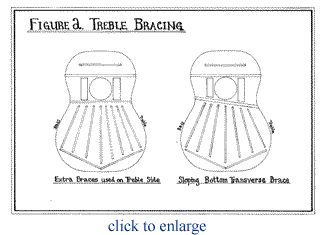Return to Hancock Classical Guitars website
The
Diversity of Modern Classical Guitar Tone and Volume due to Plate Thickness and
Bracing.
26th
December, 2006
Dane
Matthew Hancock, BEng
In
this article the effect of varying top and back thickness and using different
rigidities of top fan bracing will be explored.
Though it is true that top, back and sides material and grade will alter
the tone and volume of a guitar, this article relates to the thickness of the
top and back material and not the type or grade of material used.
It is generally believed that the back and sides contribute only a small
amount to the overall sound quality of a guitar and that the top is the single
most important element. This
statement is more correct for a guitar with a thinner top, i.e. typical Spanish
classical guitars and modern contemporary ‘lattice-braced’ guitars.
With an instrument that is tuned so the top resonates, to an extent, in
sympathy with the back, i.e. the German style concert classical guitar, the
thickness of the back and sides is somewhat more critical.
Mechanics
of the Classical Guitar
The
strength of a top with bracing must fully counter the forces produced by the
strings. The main component of this
force is a bending moment caused by the force of the strings acting over the
eccentricity of the bridge. There is also compression in the top between the bridge and
fret-board and a similar amount of 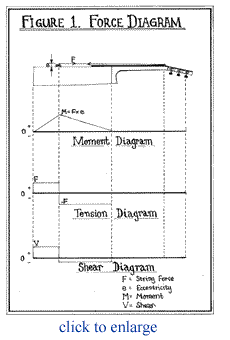 tension
between the bridge and the lower bout. The
top also contains shear force due to the bending moment caused at the bridge. These principals are shown in Figure 1. A slight convex
radius can be built into the the top to better counter force from the strings.
A convex radius is built into the back of all fine classical guitars.
tension
between the bridge and the lower bout. The
top also contains shear force due to the bending moment caused at the bridge. These principals are shown in Figure 1. A slight convex
radius can be built into the the top to better counter force from the strings.
A convex radius is built into the back of all fine classical guitars.
As
the strings are set in vibration by the player, the saddle transfers the
vibration to the bridge. The bridge
in turn transfers the vibration to the top and top bracing.
The bridge vibrates by ‘rocking’ back and forward on the top, in the
direction of the strings. The axis
that the bridge rocks on is known as the ‘fulcrum’.
A typical classical guitar bridge is essentially a string anchor and
brace. With a fan braced top, the
bridge sits on top of the central fan braces.
These braces help to transfer vibration from the bridge to other areas of
the top. As the bridge rocks back
and forth, the top vibrates and sets the air around it in motion.
This ‘air in motion’ is actually air in compression and rarefaction,
(Siminoff 2002, p.11) or sound waves. The
back and sides reflect the sound produced inside the guitar back through the
sound-hole and in the general direction of the audience.
The
higher treble frequencies of the guitar can be slightly improved by making the
treble side of the top stiffer. Higher
stiffness can be achieved by using stronger bracing or adding bracing to the
treble side of the top. Higher
stiffness can also be achieved by setting the lower harmonic bar at an angle to
keep the treble side of the top in effect shorter as can be seen in Figure 2.
A Miguel Rodriguez top has a third transverse brace running at an angle under
the sound-hole. This brace gradually stiffens the top on the treble side
only. A 'Rodriguez style' top by Kim Hancock is shown in Picture 1.
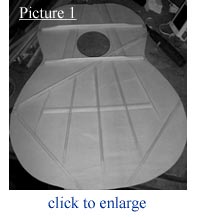 The
major part of the sound energy is produced inside the guitar and will project
through the sound-hole. A substantial amount of the sound energy produced by the
guitar is from top vibration alone (as per the harpsichord or pianoforte).
(This concept can be demonstrated by totally covering the sound-hole of a
stringed instrument and playing it. A
small part of the sound is produced by the strings alone.
Too much ‘string noise’ is undesirable for the concert performer.
The
major part of the sound energy is produced inside the guitar and will project
through the sound-hole. A substantial amount of the sound energy produced by the
guitar is from top vibration alone (as per the harpsichord or pianoforte).
(This concept can be demonstrated by totally covering the sound-hole of a
stringed instrument and playing it. A
small part of the sound is produced by the strings alone.
Too much ‘string noise’ is undesirable for the concert performer.
The
Effect of a Thinner Top
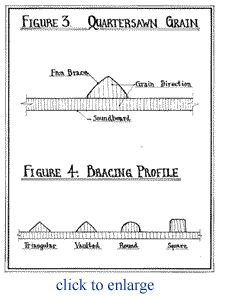 Obviously,
the thinner a top is made, the stronger the top braces will have to be to
counter the constant force produced by the strings.
The material used for the braces in traditionally constructed classical
guitars is usually the same material used for the top.
(Sometimes spruce bracing is used with a cedar top.)
The grain in
the braces and top should be orientated so that it is quarter-sawn, (see Figure
3). This gives the top and bracing
the most available strength when counteracting the forces produced by the
strings. Simply, for the same
material, a stronger brace will be either thicker, wider or both.
Most top braces are rounded, vaulted, or some are left square, (see
Figure 4).
Obviously,
the thinner a top is made, the stronger the top braces will have to be to
counter the constant force produced by the strings.
The material used for the braces in traditionally constructed classical
guitars is usually the same material used for the top.
(Sometimes spruce bracing is used with a cedar top.)
The grain in
the braces and top should be orientated so that it is quarter-sawn, (see Figure
3). This gives the top and bracing
the most available strength when counteracting the forces produced by the
strings. Simply, for the same
material, a stronger brace will be either thicker, wider or both.
Most top braces are rounded, vaulted, or some are left square, (see
Figure 4).
Within
limits as a top is made thinner the tone will become crisp, dry and more
fundamental. ‘Fundamental’
refers to the sound character produced when the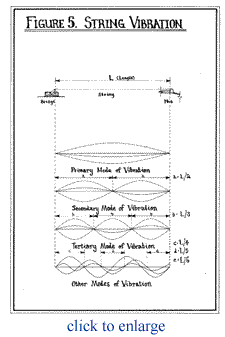 principal mode of vibration of a
string (full length) is more prevalent than the secondary (half string),
tertiary (third of string), and so on, (Bacon et al 2002, p.94).
This concept can be seen in Figure 5.
This type of ‘fundamental’ tone is more suited to polyphonic music.
principal mode of vibration of a
string (full length) is more prevalent than the secondary (half string),
tertiary (third of string), and so on, (Bacon et al 2002, p.94).
This concept can be seen in Figure 5.
This type of ‘fundamental’ tone is more suited to polyphonic music.
Antonio de Torres Jurado, (born 1817, Almeria, Spain), was the first guitar maker to combine fan bracing, a larger plantilla and the now standard 650mm (25.5 inch) scale-length. Torres is considered to be the father of the modern classical guitar and rightly deserves ‘a place on the Olympus of instrument makers’, (Grondona & Walder 2002, p.14). Guitars such as Torres tend towards a thinner top and thicker back. Torres believed that the back and sides contributed very little to the sound quality of a guitar (Romanillos 1987, p.81). An example if a 'Torres Style' braced top by the author is included in Picture 2.
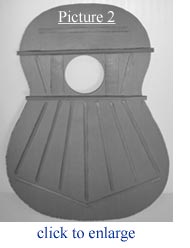 A
concert classical guitar with a thin top will generally lead to a louder guitar.
This characteristic is shown to its limit in contemporary
‘lattice-braced’ concert classical
guitars. A thinner top will vibrate more freely and the sound will
reflect off the back and sides, rather than vibrate in sympathy with the back.
The back and sides on a lattice-braced guitar are typically very thick
and in some cases laminated.
A
concert classical guitar with a thin top will generally lead to a louder guitar.
This characteristic is shown to its limit in contemporary
‘lattice-braced’ concert classical
guitars. A thinner top will vibrate more freely and the sound will
reflect off the back and sides, rather than vibrate in sympathy with the back.
The back and sides on a lattice-braced guitar are typically very thick
and in some cases laminated.
The
Effect of a Thicker Top
A
thicker top will have more inherent strength and, therefore, need less support
from bracing. This style of
instrument was perfected by Hermann
Hauser I ‘the first non-Spanish luthier to make truly great modern classical
guitars’, (Evans T & M 1977, p.65). This
thicker top is the reason that the fan bracing on a Hauser style guitar is
typically very fine in comparison to the top bracing of a typical Spanish
guitar. It is interesting to note
that the Viennese guitar has only transverse top bracing, with no fans at all (Jahnel
1981, p.152-3). The back on a
Hauser style guitar is thicknessed so that the top resonates with the back in
sympathy. This can become a tedious
process for the luthier when building the instrument, as not only the top is
tuned, but also the back is tuned to the top.
This thicknessing/ tuning process can also be very fine and only small
fractions of a millimeter will have a huge effect on the finished sound of the
guitar. This thicknessing will not
only change the volume, but to a great extent the tone.
Perfecting the tuning process requires minute adjustments to previously
built instruments based on experience and intuition. However, the results are well worth the effort as this style
of concert classical guitar has a rich, sweet, brooding and diffused tone.
The timbre of these instruments can also be coloured, to a reasonable
extent, by the type of material used for the back and sides, more so than a
Spanish style instrument. Another great quality inherent of this style of guitar is the
balance obtained across the full range.
Thick
versus Thin
An
instrument has to be as light as possible to take the force of the strings and
also have enough top and back material to generate a full rounded tone (not too
dry, not too diffused).
If
the top is too thin the tone will be harsh and ‘honky’.
This is indeed a problem with contemporary lattice-braced guitars.
It is true that great volume can be obtained with these instruments, and
some of the world finest classical guitar virtuoso’ play this style of
instrument with much success, most notably John Williams who now plays a Greg
Smallman guitar exclusively in his concerts.
However, many artists find the sound quality produced by lattice-braced
guitars is somewhat inappropriate for the traditional classical guitar
repertoire.
If
the top is too thick the tone will be too diffuse and the projection will be
low. Therefore, tuning a fine
concert classical guitar is an essential and time-consuming task.
There
are guitars made from the finest master-grade quarter-sawn top material and
stunning Brazilian rosewood back and sides, that have not been tuned properly,
and do not have a great sound. In
some cases these instruments can look stunning and be built extremely well,
however, they are completely deficient in tone and projection when played.
Sometimes, in factory-produced guitars, tuning is to an extent
overlooked. This is due to these
instruments being built to plans that are restricted to accommodate a wide range
of material strengths. Generally
this will lead to a heavier guitar, which is greatly lacking in projection,
particularly in the treble strings.
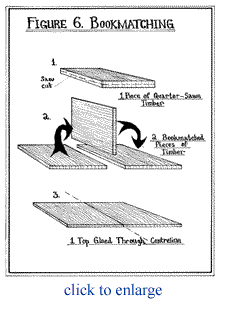 Conversely,
there are some great sounding instruments built with unmatched, lower grade
tops, with low-grade locally available back and sides.
Of particular note, Torres instruments were built from materials
available to Spain in the 19th century.
Many of Torres tops were not book-matched, (see Figure 6.).
However, this was possibly done on purpose as the finer grade, stiffer
material was commonly used on the treble side.
Some back, sides, neck and even bracing material contained visible knots.
For example a knot is visually apparent Torres SE111 (Opus 111) on the
lower right side of the back. This particular instrument is considered by some
classical guitar authorities to be finest surviving Torres (Grondona &
Waldner 2002, p46.). These examples serve to illustrate how important, and
sometimes overlooked, the tuning process is for a fine concert classical guitar.
Conversely,
there are some great sounding instruments built with unmatched, lower grade
tops, with low-grade locally available back and sides.
Of particular note, Torres instruments were built from materials
available to Spain in the 19th century.
Many of Torres tops were not book-matched, (see Figure 6.).
However, this was possibly done on purpose as the finer grade, stiffer
material was commonly used on the treble side.
Some back, sides, neck and even bracing material contained visible knots.
For example a knot is visually apparent Torres SE111 (Opus 111) on the
lower right side of the back. This particular instrument is considered by some
classical guitar authorities to be finest surviving Torres (Grondona &
Waldner 2002, p46.). These examples serve to illustrate how important, and
sometimes overlooked, the tuning process is for a fine concert classical guitar.
References
used in this article
Bacon
T, Cooper C, Van Eik J, Fowles P, Jeffrey B, Johnston R, Miklaucic T,
Morrish J, Rebellius H, Richardson Dr. B, Sparks Dr. P & Wade G, Zern
B 2002, The Classical Guitar-A Complete History, Backbeat Books/ Outline
Press Ltd, London.
Evans
T & M 1977, Guitars - Music, History, Construction and Players From the
Renaissance to Rock, Oxford University Press, London.
Grondona
S & Waldner L 2002, La Chitarra Di Liuteria (Masterpieces of Guitar
Making), l’officina del libro, Sondrio.
Jahnel
F 1981, Manuel of Guitar Technology, Bold Strummer Ltd, Connecticut.
Romanillos
J.L 1987, Antonio de Torres Guitar Maker-His Life and Work, Bold Strummer
Ltd, Connecticut.
Other
Useful References
Brosnac
D 1978, An Introduction to Scientific Guitar Design, Bold Strummer Ltd,
New York.
Courtnall
R 1993, Making Master Guitars, Robert Hale, London.
Romanillos
J & Harris M 2002, The Vihuela de Mano and The Spanish Guitar – A
Dictionary of the Makers of Plucked and Bowed Musical Instruments of Spain,
The Sanguino Press, Guijosa.
Siminoff
R 2002, The Luthier’s Handbook A Guide to Building Great Tone in Acoustic
Stringed Instruments, Hal Leonard, Wisconsin.
Urlik,
S 1997, A Collection of Fine Spanish Guitars From Torres to the Present,
Sunny Knoll Publishing Company, California.
Wade
G 2001, A Concise History of the Classic Guitar, Mel Bay, Missouri.
Return to Hancock Classical Guitars website
© Dane Hancock 2006. All rights reserved
